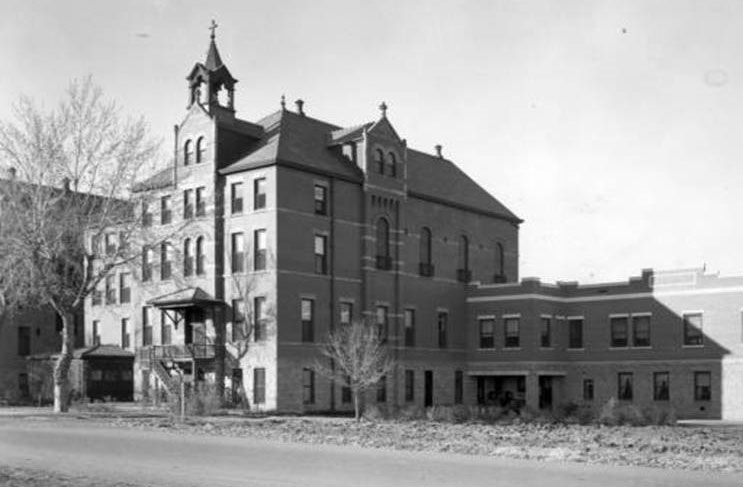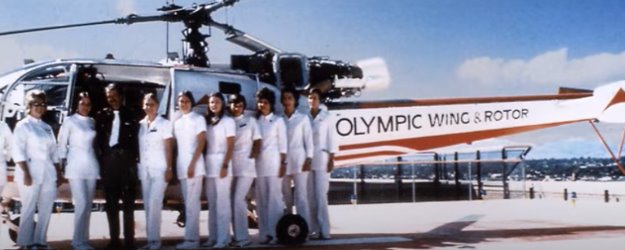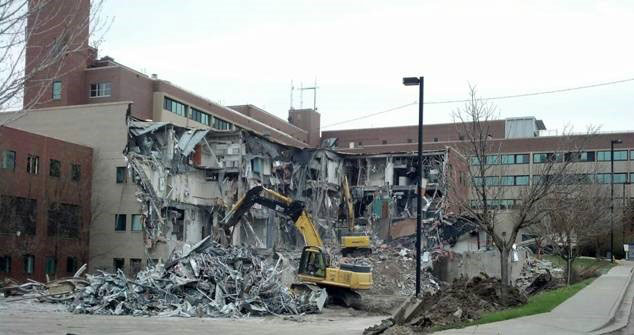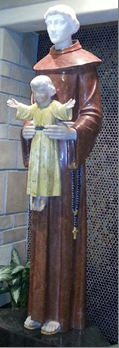History of Philanthropy at St. Anthony Hospital
Written by Darcy Copeland, Nurse Scientist and Housewide Educator
In 1890, the superintendent of St. Francis, Sister Mary Huberta Duennebacke, moved to Denver to begin preparations for a hospital solely owned and operated by the Sisters of St. Francis.
The bishop at that time, Nicholas Matz, felt the project was too difficult and expensive. Sister Huberta reported, “We will begin, and St Anthony will help us.”
Teams of two sisters went door to door in Denver raising money (some did not speak English). They traveled by horseback and wagon to mountain mining camps such as Central City, Blackhawk, Idaho Springs, and Cripple Creek. Barber shops and saloons were reportedly good places to find supporters. Union Pacific physicians let the Sisters know where the railroad crews were working so they could be waiting outside of cashier’s cage on payday.
These railroad workers and miners not only donated their money, but provided food and shelter to the sisters on their fundraising expeditions, which often lasted weeks.
On June 13, 1893, seventeen Sisters of St. Francis of Perpetual Adoration opened their new $190,000 St. Anthony Hospital on Manhattan Lake in the town of Highland, overlooking the city of Denver from the west. The town of Highland was between 26th to 38th Avenues west of Gallup (Zuni) Street. Manhattan Lake later became part of Sloans Lake.
St. Anthony Hospital was a four-story brick building trimmed with granite. It had a steam-powered elevator and when there wasn't enough coal to provide steam, the Sisters carried patients up and down the stairs. One of the sisters carried coal to the boiler house; three sisters milked cows and did the canning, cooking, and scrubbing.
In 1901, the new $40,000 East Wing was opened, adding surgery and x-ray departments as well as a chapel.

In 1919, the new $200,000 West Wing was added. The first 3 floors housed about 70 beds, while the 4th floor was used for nursing students from the St Anthony Hospital School of Professional Nursing. The school was established on March 23, 1919. It was a 3-year diploma program and graduated its first class of 12 in 1922.
In 1920, a two story addition was constructed on the north end of the main building. It housed the convent, a pathology laboratory, and the medical records library.
In 1940, the Nurses Home was constructed. 25-30 beds were added to the 4th floor of the hospital, becoming the pediatric unit.
Over the next 50 years there was a great deal of expanding and building.

On April 4, 1953 St Anthony Hospital received full approval from the Joint Accreditation Committee. (Accreditation to hospitals by this organization began in January, 1953).
In September 1954, the physical therapy department opened.
On March 8, 1963 an 8 bed ICU opened on 3W. The unit provided private duty nursing to the acutely ill in need of constant attention. In preparation for the opening, a series of in-service educational classes were conducted by the Medical Staff and the In-Service Director to ensure proper policy, advanced training and close-working harmony. The unit included the latest in emergency equipment, supplies, medications, etc. In retrospect, this was a real advancement for St Anthony’s, and was a big step forward in improved patient care.
In 1972, St. Anthony Hospital established the first hospital-based air ambulance program in the United States.

In 1973 the Institute of Emergency Medical Training was established. At the time it was one of the first full-service emergency medical systems in the United States. Three elements of the system were: state-of-the-art-ED with Level I Trauma room capabilities, Flight For Life helicopter ambulance, and a formal emergency medical training program.
In 1977 Trauma Room 10 opened as a special operating room designated for those in need of immediate surgery.
June 19, 2011, 120 patients (48 critical care patients) were moved from St. Anthony Central hospital to our new facility.

On January 11, 2013, the St. Anthony Central Hospital campus was sold to Enviro Finance Group, with future plans announced for the development of a residential, mixed-use neighborhood. As part of our legacy and ongoing commitment to the community, St. Anthony Sloan’s Lake Health Center, which provides primary care services, will remain on the campus.
 The heritage we have comes from 2 sources.
The heritage we have comes from 2 sources.
Our legacy from the Sisters of St Francis of Seraph is to provide care to the poor and disenfranchised. They faced tremendous adversity and fought very hard for what they believed in – caring for the poor and disenfranchised.
Our namesake, St Anthony, also a Franciscan, is the patron saint of lost items, poor, travelers, and those who have been uprooted. While the physical setting of our health care ministry has changed we honor the legacy of St. Anthony and the Sisters of St. Francis through our service to the poor and compassion for those who are lost and suffering. Our commitment is demonstrated through the $63 million dollars in community benefit we provide each year.